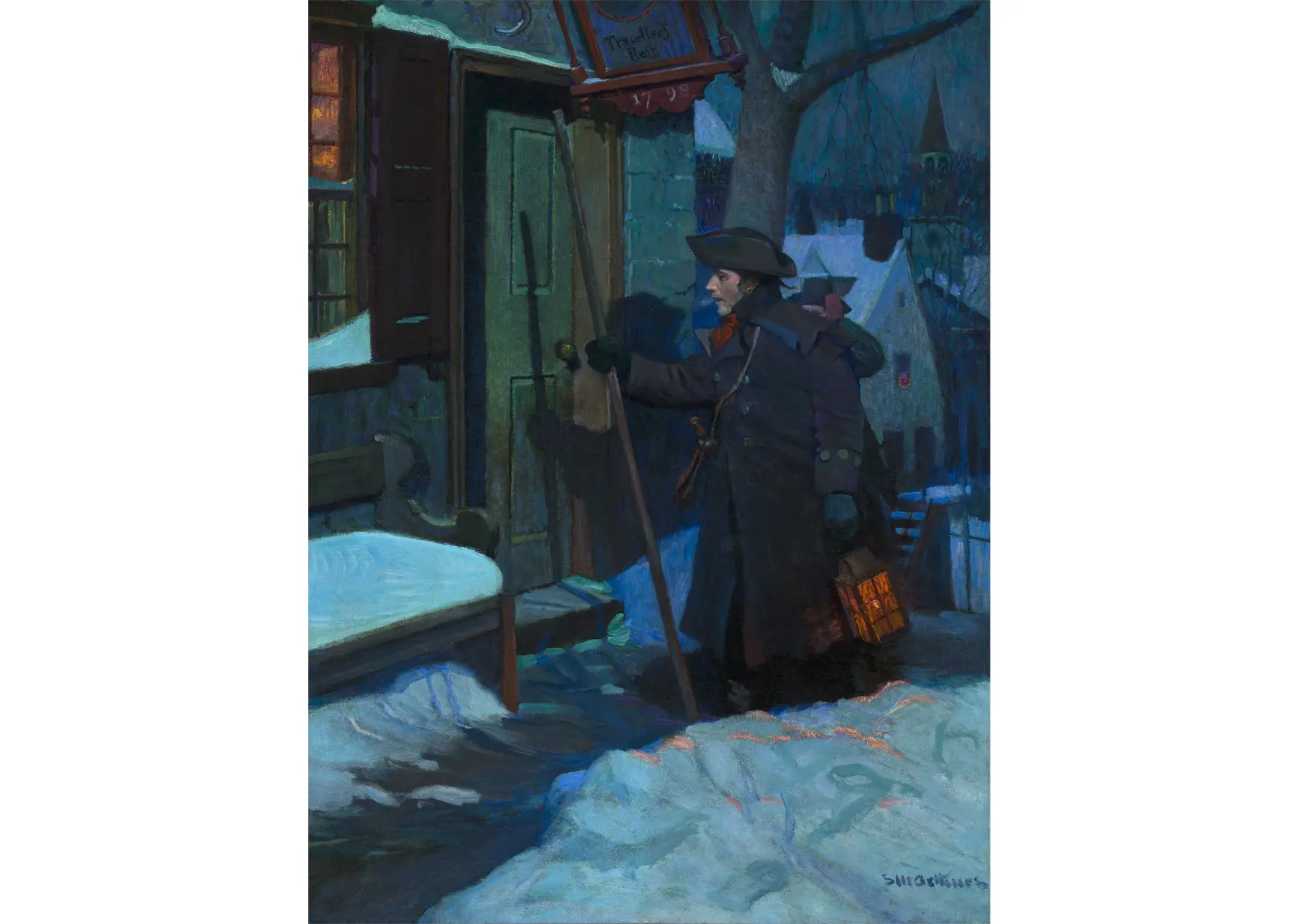When most people think about the Jazz Age, they do not think about the romantic, swashbuckling paintings of Howard Pyle, who died in 1911, well before the era commenced. However, Pyle left behind dozens of students, including many who were already established as professional illustrators. By the beginning of the Jazz Age in 1919, Frank Schoonover, Jessie Willcox Smith, and N.C. Wyeth were among the nation’s most popular illustrators. Like their teacher, Pyle’s former pupils illustrated stories in books and magazines, but they also produced pictures for advertisements, calendars, and posters. In the 1910s and ’20s, the world of illustration changed as color printing became more affordable and dozens of new periodicals were founded, increasing the demand for skilled illustrators. Magazine covers and book jackets—previously rather dull spaces—became high-profile opportunities for full-color illustrations. And corporations turned to mass-market magazines to advertise nationally, commissioning top-notch illustrators to produce elaborate pictures to promote their products.
Jessie Willcox Smith became a household name through her illustrations for the expanding magazine industry. She specialized in images of children, and her work appeared on the covers of Good Housekeeping from 1918 to 1932, as well as in books, calendars, and posters. One writer explained her popularity by noting that that her young subjects “don’t look noisy…are unusually wholesome…and seem only sufficiently naughty to be entertaining.” Typical of her approach, the watercolor School Again! features a bored but compliant child, who looks like she would much rather be outside exploring—note the map behind her—than stuck in a classroom. This was an ideal seasonal cover for the October 1928 issue. At the time, Good Housekeeping arrived in about one million households each month!
 New Year’s Eve, for an advertising calendar for Brown & Bigelow, 1928. Stanley Arthurs (1877–1950). Oil on canvas, 35 ½ x 26 3/8 inches. Delaware Art Museum, Louis du Pont Copeland Memorial Fund, 1930.
New Year’s Eve, for an advertising calendar for Brown & Bigelow, 1928. Stanley Arthurs (1877–1950). Oil on canvas, 35 ½ x 26 3/8 inches. Delaware Art Museum, Louis du Pont Copeland Memorial Fund, 1930.
Pyle’s students, Stanley Arthurs, Harvey Dunn, Schoonover, and Wyeth excelled at illustrating adventure stories and tales set in the American past. In colorful and dynamic oil paintings they brought to life the escapades of pirates, patriots, and cowboys. Their work appeared in advertisements for Cream of Wheat and Duco automobile paint and on calendars given away by corporations eager to keep their names on the walls of American homes and businesses.
 Cover for The Three Musketeers by Alexandre Dumas (Boston: Dodd, Mead and Company, 1929). Mead Schaeffer (1898–1980). Oil on canvas, 32 x 26 inches. Collection of Brock and Yvonne Vinton.
Cover for The Three Musketeers by Alexandre Dumas (Boston: Dodd, Mead and Company, 1929). Mead Schaeffer (1898–1980). Oil on canvas, 32 x 26 inches. Collection of Brock and Yvonne Vinton.
Wyeth may be best remembered for illustrating literary classics like Treasure Island, which were published by Scribner’s throughout the early 20th century. Dunn spread Pyle’s legacy by teaching, as well as illustrating. Dunn’s student Mead Schaeffer was responsible for his own series of more than a dozen illustrated classics for Dodd, Mead and Company. His stellar cover design for The Three Musketeers is featured in the exhibition.
Having made his name creating beautiful books for American youth, Pyle was an important influence on these publications. In 1921, a critic for the New York Tribune marveled: “There never has before been such a wealth of children’s books from which to choose an appropriate Christmas gift for the boy or girl of any age.” She began her recommendations with the newly released compilation, Howard Pyle’s Book of Pirates, a volume of his stories and pictures which would influence illustrators and filmmakers for generations. Two years later, Pyle’s historical subjects received similar treatment in Howard Pyle’s Book of the American Spirit. Five of Pyle’s most popular books were reissued by Scribner’s in 1933 as the Howard Pyle Brandywine Edition with newly painted frontispieces and introductory notes by his students. Despite his death decades earlier, Pyle remained present in the American consciousness throughout the 1920s and ’30s.
Also, during the Jazz Age, the organization that would become the Delaware Art Museum continued to assemble our outstanding collection of paintings and drawings by Pyle and his students. Many of these pictures would go on view permanently when the Museum opened its first building in 1937.
Opening at the Museum on October 5, 2024, the exhibition Jazz Age Illustration highlights Pyle’s legacy through the work his students produced between 1919 and 1942. A longer essay about this subject is available in the exhibition catalogue.
Heather Campbell Coyle
Curator of American Art
Top: School Again! Cover for Good Housekeeping, October 1928. Jessie Willcox Smith (1863–1935). Watercolor and charcoal on paper, 16 7/8 x 17 3/8 inches. Delaware Art Museum, Louis du Pont Copeland Memorial Fund, 1971.

